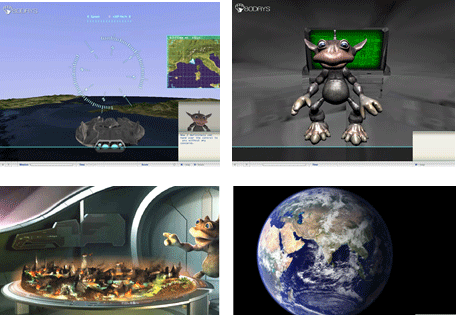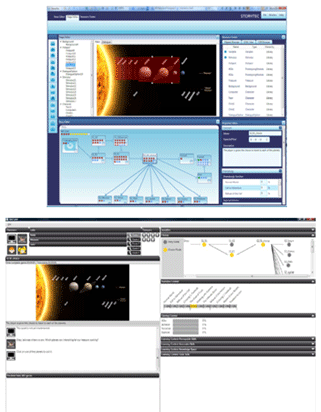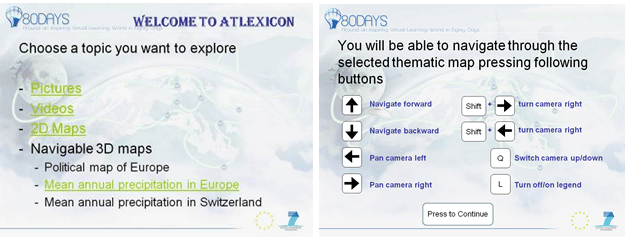|
|
   |
Computer
games have become an incredibly successful part of today’s
entertainment landscape. With increasing time people
spend on computer games, the idea of utilizing their
motivational and didactic potential for educational
purposes is getting more popular and fascinating. The
European research project 80Days (www.eightydays.eu)
is inspired by Jules Verne’s novel “Around
the world in eighty days”. The project aims at
developing the necessary psycho-pedagogical and technological
foundations for successful digital educational games
– successful in terms of educational effectiveness
as well as financial turnovers.
|
The basis
for 80Days’ mission is an intelligent technology
that allows an adaptation to individual learners, their
prior knowledge, abilities, preferences, needs and aims.
By this means the learner will have optimal motivation
to play and therefore to learn, because s/he is perfectly
challenged, and neither overburdened by too difficult
gaming and learning activities, nor bored by too simple
ones. In 80Days, this kind of adaptation is realized
by providing the learner with adequate psycho-pedagogical
interventions (e.g., hints or feedbacks) but also by
the adaptation of the entire gaming context and ambience
(e.g., the level of difficulty, the mood, the pace,
or even the entire storyline). The very nature of the
80Days project is melding adaptive educational technology
with interactive and adaptive storytelling. In the rich
context of DEGs with their large degrees of freedom,
individualization as well as adaptation requires an
in-depth understanding of the learners and their behaviour
within a DEG. .
|

Screenshots of 80Days’ demonstrator game, code
name
Lizard, teaching geography for a target audience of
12 to 14 year old children. |
Another challenge
is not destroying the flow of the gaming experience
by educational guidance and knowledge assessment procedures.
To meet these requirements, cognitively sound models
of a learner’s behaviour within virtual learning
environments are essential. Moreover, while traditional
approaches to adaptive educational technologies primarily
focus on knowledge and learning progress, digital games
constrain the consideration of aspects such as individual
preferences (e.g., visual styles or gaming genre), individual
motivation, collaboration, or (problem solving) behaviour.
Existing, primarily competence-based, cognitive models
for adaptive educational technologies must be merged
with theories of (achievement) motivation and models
of interactive and adaptive storytelling in order to
establish a comprehensive theoretical framework for
combining learning and gaming
A weak spot of utilizing
digital games for educational purposes is the high level
of development costs, in terms of assets production
and didactic design. The overall costs for developing
DEGs, however, must be justified by educational efficacy,
by an appropriate balance between gaming and learning,
and - most importantly - by the market for specific
educational game genres. The reduction of development
costs is a crucial factor for publishers of educational
material and game developers in so far as the market
for games with specific educational aims can be considered
to be significantly smaller than the global market for
recreational or commercial games. Therefore, a technological
as well as psycho-pedagogical framework must be established
that enables to reduce the costs and shorten the development
lifecycle. Essentially, this shall be accomplished by
providing generic frameworks and models for adaptive
interventions, interactive and adaptive storytelling,
the (re-)use of one base game to create multiple games
by realizing different game scenarios and even entirely
different games on the basis of a single pool of (expensive)
game assets (e.g., 3D objects), and the integration
of existing learning resources. This methodological
framework shall allow either publishers, educators,
or learners to choose from different classified game
genres and styles as well as from different learning-related
factors (e.g., the learning goals or preferences) in
order to realize tailored learning experiences. Making
development more effective also includes theoretically
and empirically sound evaluation and validation methods.
The project’s achievements
are outstanding. 80Days has significantly advanced the
state of the art in the application of personalised
technology-enhanced learning techniques to digital educational
games by an advanced level of research work.
Psycho-pedagogical research
made significant progress by elaborating a joint formal
model of cognitive educational assessment on a probabilistic
level, the provision of suitable support and interventions,
and open, interactive, adaptive storytelling. From a
technical point of view we developed a comprehensive
multi-adaptive system, integrating assessment engines,
reasoning services, adaptation engine as well as a software
engine driving the story telling and story pacing. Thus,
within the project a real-time knowledge driven approach
to implicit learner competency assessment has been realised.
This modelling of the learner enables both micro and
macro personalisation.
As a manifestation of
research achievements, the project developed two amazing
demonstrators. On the one hand a compelling educational
game teaching geography. The code of the game is Lizard.
Lizard is a learning adventure that is supposed to teach
geography for the age group of 12 to 14 years. The curriculum
includes, for example, knowledge about the planet Earth
such countries or cities but also aspects such as longitude
or latitude. In the game the learner takes the role
of a boy or a girl (depending on the learners’
gender) at the age of 14. The story starts from an extraordinary
event; a space ship is landing in the backyard and an
alien named Feon appears. Feon turns out to be a friendly
alien, being an alien scout who has to collect information
about foreign planets, in this case planet Earth. The
learner accompanies Feon and is having fun with flying
a space ship and exploring interesting places on Earth.
Feon creates a report about the Earth and its geographical
features. This is accomplished by the player by means
of flying to different destinations on Earth, exploring
them, and collecting and acquiring geographical knowledge.
The goal is to send the Earth report as a sort of travelogue
about Earth to Feon’s mother ship. At a certain
point in the game, however, the player makes a horrible
discovery;
|
|

Screenshots of 80Days’ authoring
tool
StoryTec (left panel) and the related demonstrator Bat
Cave (right panel).
|
the aliens are not really friendly
but collect all the information about Earth to conquer
the planet, lately. This discovery reveals the “real”
goal of the game: The player has to save the planet
and the only way to do it is to draw the right conclusion
from the traitorous Earth report. The subject matter
is embedded in hat story and learning occurs at various
events in the game. From a pedagogical point of view,
learning occurs by receiving information (e.g., seeing/reading
something in the game or hearing something from Feon
or other game characters), problem solving (e.g.,
reducing the negative impacts of a flood by appropriate
“terra-forming”), or imitation (e.g.,
watching other game characters and learning from their
behaviours).
In addition to the immersive demonstrator
game, we developed a demonstrator to potentially show
the full capabilities of our technological approach
to multi-axes educational adaptation. The code name
is Bat Cave. Bat Cave mimics a complete game and allows
the beholder to explore various kinds of adaptive
mechanisms. The demonstrator is composed of an interaction
part and a control panel. On the interaction side,
Bat Cave ‘explains’ what is happening
and allows the user to interact with the game in a
simple form. In the control panel the user can monitor
what the adaptive technology behind is doing. For
example, the user can monitor a specific learner’s
paths through a game’s different storylines
or the learning process and how it is supported by
80Days’ adaptive technology. Bat Cave works
closely together with StoryTec, a powerful authoring
tool to generate multi-adaptive game lines.
|
>Finally, in
the third period, we developed a third demonstrator
strand, named “Atlexicon”, which is supposed
to demonstrate the re-usability of the developed contents
and assets outside of a computer game. In that sense,
Atlexicon is a demonstrator of an interactive Atlas.

Screenshots of the
Atlexicon demonstrator, an interactive Atlas.
To complete the lifecycle
of research, design, development, in a next step, the
demonstrators were subject to in-depth evaluation activities
with schools in the UK and in Austria. Empirical findings
of more than hundred participants yielded beneficial
effect of adaptive interventions and an overall satisfying
usability and user experience. Implications for the
future development of the game prototypes and the design
of evaluative activities have been drawn. In particular,
the theoretical knowledge and practical experience thus
gained will contribute to advancing the research area
of evaluating usability and user experience in digital
educational games.
Finally, the project was
highly successful in disseminating its achievements.
In total, the consortium published 8 articles in peer
review journals, attended several conferences and other
events in total, the dissemination activities sum up
to over 100 events and publications. The strongest impact
might have the books, (to be) published by the project;
this refers to the Workshop proceedings, published in
October 2009 and, more importantly to the methodology
guide book, to be published in late 2010.
|
|
|
      |
  |
|



